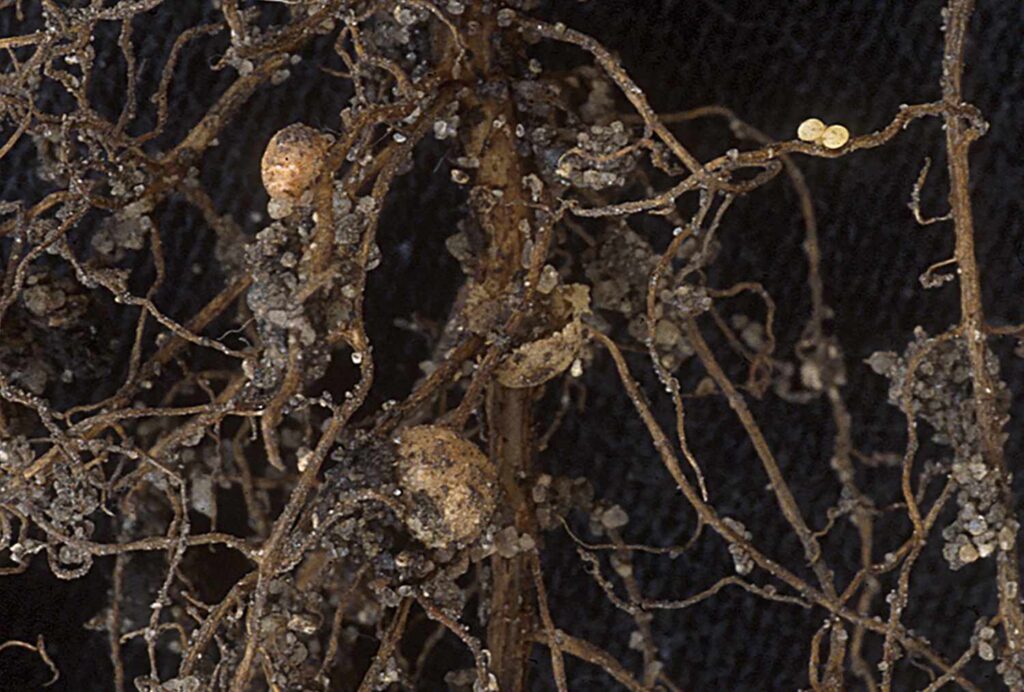The SCN Coalition, in partnership with Syngenta, Indigo, and BASF, has named today National Nematode Day in an effort to raise awareness about the threat of soybean cyst nematode (SCN). The pest is the No. 1 yield-robbing pathogen for soybeans in North America, costing producers an estimated $1.5 billion in yield loss each year.
Although obvious symptoms of the pest may not have shown up in the field this year, yield losses may have occurred undetected.
“I think it’s going to be a deceptive year for a lot of growers because we’ve had a little bit more rain than usual,” said Dylan Mangel, an Extension plant pathologist at the University of Nebraska. “Some of those symptoms can be hidden, so something that’s already hard to detect may be a little harder still. That doesn’t mean they’re not gonna be struggling with some level of yield loss associated with a widespread nematode problem.”
Test Your Soils
Soiling testing for SCN numbers is vital due to the pest’s growing resistance to PI-88788 — the most common source of SCN resistance in soybean seeds. The SCN levels in your field can guide your management plan and provide a better understanding of yield-loss risk.
While soil tests for SCN can be conducted year round, harvest season may provide the most accurate results for those with a two-year corn-soybean rotation.
“The nematode levels are going to hit their peak at the end of the soybean season,” Mangel said. “Then they’ll taper down through the corn season and be at their lowest levels just before you plant soybeans again. Soil sampling at the end of the soybean season is your best chance at catching them if they’re there.”
Soil samples should be taken from a uniform landscape. If a field has high and low areas, take two different composite samples. Also consider targeting areas with high pH levels, increased soil movement, sudden death syndrome symptoms, or low yields.
Recommendations typically call for soil tests every 3-5 years, or every second or third soybean crop. To accurately compare tests, samples should be taken at the same time of year each time.
“Soil sampling every second soybean crop over a period of years will give you a general idea of how SCN levels are changing and if management practices are working,” said Dale Ireland, technical product lead for Syngenta. “It’s not a snapshot in time. This is a long-term management approach.”
Several states — including Nebraska and Ohio — offer free testing opportunities. Contact your local Extension experts for more information.
To further understand your field’s risk, The SCN Coalition has created the SCN Profit Checker — a free tool to estimate yield loss risk based on location, SCN egg count levels, soil data, and expected yield.
Upcoming Management Tools
Soybean varieties with alternate resistance genes, namely Peking, and seed treatment options have provided a solid foundation for SCN management. Even more tools are on the horizon with promising preliminary results.
Nemasphere
Developed by BASF, Nemasphere is a transgenic trait that produces a novel Cry14 protein which interferes with nematode nutrient uptake. Advanced field testing and more than 200 field trials in the U.S. showed Nemasphere can boost yield potential by 8%.
BASF plans to stack the trait with the Enlist E3 herbicide tolerance trait, and is working towards market availability in 2028, pending regulatory approval.
Victrato Seed Treatment
An upcoming seed treatment from Syngenta, Victrato is currently under regulatory review by the EPA. Featuring a novel SDHI active ingredient, TYMIRIUM technology, the seed treatment will offer protection against the adults, juveniles, and eggs of several nematode species. Victrato will also provide early-season suppression of foliar soybean diseases.
Trials conducted from 2015-2022 showed an 84% yield advantage when using the product.
Stewardship of Management Tools
As SCN’s resistance to PI88788 continues to rise, good stewardship is necessary to extend the life of new and existing tools. Rotation — both SCN resistant varieties and non-host crops — and integrated management is key.
“If you find a good variety, the last thing you want to do is switch,” Mangel said. “But switching it up will make that variety and those resistance sources stronger for longer. Don’t give nematodes a chance to find new ways to work around those varieties.”

